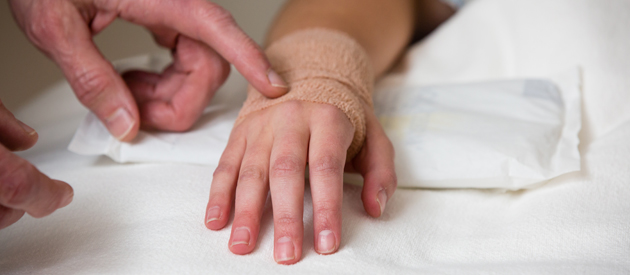The Intricacies off Carpal Tunnel with Dr. Andrew Staiger

The human hand is incredibly complex. For Dr. Andrew Staiger, that complexity is what attracted him, as an orthopedic surgeon, to specialize in matters of the hand.
With 29 major joints, 123 ligaments, 24 muscles, 48 nerves, and 30 arteries, operating on the hand is no small feat. Every case brings a new challenge as you navigate through the intricacies of the human hand’s anatomy. These challenges are ones Dr. Staiger faces head-on. He knows how important it is to have proper function in your hand and no pain because for most of us, it’s how we communicate, touch, work, and so much more. Whether you are experiencing pain from arthritis, carpal tunnel, trigger finger, or another hand issue, Dr. Staiger and the team of Orthopedic Hand Surgeons at St. Cloud Surgical Center are here to help you get back to living your life without pain.
While there are many common issues of the hand, today we’re going to discuss Carpal Tunnel Syndrome, a condition that affects 3 to 6% of the adult population. For many years, we believed the cause of carpal tunnel was an overuse of keyboards, pianos, etc. but in recent years, studies have shown there is no known cause for carpal tunnel. It is an idiopathic condition, meaning “of itself”, there is no certain origin, and it arises spontaneously in the general population.
Carpal tunnel syndrome occurs on its own when a thickening along the tendons occurs. The carpal tunnel is a very finite space, and when this thickening takes place, the nerve is trapped or pinched and starts causing symptoms of numbness, tingling, weakness, or pain. For some patients, it can be managed without surgery by doing the following:
- Frequent breaks to rest hands
- Avoiding Activities that make symptoms worse
- Nerve gliding techniques and hand/wrist stretches which can be taught by a hand therapist
- Wrist splinting during aggravating activities and while sleeping to relieve nighttime symptoms of tingling and numbness
- Intermittent use of nonsteroidal anti-inflammatory drugs (ibuprofen, Advil, Motrin, etc.) and/or acetaminophen (Tylenol) may relieve pain in the short term
- Use of corticosteroids injected by a physician into the carpal tunnel to relieve pain may provide short-term benefits as well
After trying a combination of these non-surgical methods and seeing little relief, it may be time to consider surgery with a physician like Dr. Staiger at St. Cloud Surgical Center. The Carpal Tunnel Release procedure is the most common among hand surgeons, and with a success rate of 98%, it is also the most successful. The outcomes of this procedure are very good, and the chance of recurrence is around 5%. If recurrence does emerge, it would typically be 10 to 15 years down the road. Carpal Tunnel Release surgery has been shown to be a very safe and effective option to relieve the pain you are experiencing with very low risks.
There is a short amount of rehab and recovery that will take place after your surgery. Dr. Staiger recommends gripping and lifting no more than 5 lbs during the first 6 weeks of healing. The symptoms patients experience before surgery typically resolve very quickly after surgery making this one of the best life-altering procedures available. If you are experiencing these symptoms, we can help!
For more information or to schedule an appointment with Dr. Andrew Staiger to talk about your symptoms, click here.
Sources:
Interview with Dr. Andrew Staiger